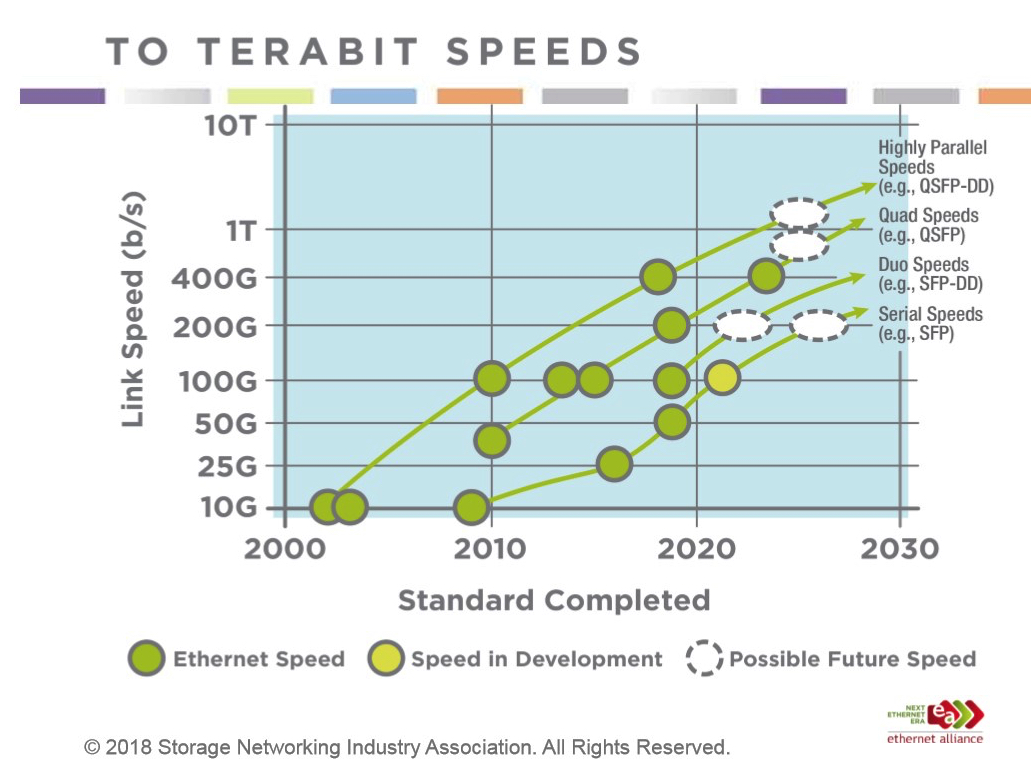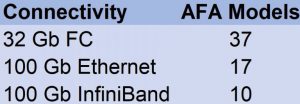Fast Network Connectivity Key to Unlocking AFA Performance
By Ken Clipperton, DCIG
This is a Press Release edited by StorageNewsletter.com on July 23, 2019 at 2:05 pm This article, published on July 18, 2019, was written by Ken Clipperton, lead analyst for storage, DCIG LLC.
This article, published on July 18, 2019, was written by Ken Clipperton, lead analyst for storage, DCIG LLC.
Fast Network Connectivity Key to Unlocking AFA Performance
The current generation of AFAs offers enough performance to saturate the network connections between the arrays and application servers in the data center. In many scenarios, the key limiter to AFA performance is storage network bandwidth. Therefore, AFA vendors have been quick to adopt the latest advances in storage network connectivity.
Fast Networks are Here, and Faster Networks are Coming
Ethernet is now available with connection speeds up to 400Gb/s. FC now reaches speeds up to 128Gb/s. As discussed during a recent SNIA presentation, the roadmaps for both technologies forecast another 2x to 4x increase in performance.
While the fastest connections are generally used to create a storage network fabric among data center switches, many AFAs support fast storage network connectivity.
Fast Networks are Here, and Faster Networks are Coming
Ethernet is now available with connection speeds up to 400Gb/s. FC now reaches speeds up to 128Gb/s. As discussed during a recent SNIA presentation, the roadmaps for both technologies forecast another 2x to 4x increase in performance.

While the fastest connections are generally used to create a storage network fabric among data center switches, many AFAs support fast storage network connectivity.
AFAs Embrace Fast Network Connectivity
DCIG’s research into AFAs identified 37 models that support 32Gb FC and 17) that support 100GbE, and 10 that support 100Gb IB connectivity. These include products from Dell EMC, Fujitsu Storage, Hitachi Vantara, Huawei, Kaminario, NEC Storage, NetApp, Nimbus Data, Pure Storage and Storbyte.
 (Source: DCIG)
(Source: DCIG)
Other Drivers of Fast Network Connectivity
Although all-flash storage is a key driver behind fast network connectivity, there are also several other significant drivers. Each of these has implications for the optimal balance between compute, storage, network bandwidth, and the cost of creating and managing the infrastructure.
These other drivers of fast networking include:
• Faster servers that offer more capacity and performance density per rack unit
• Increasing volumes of data require increasing bandwidth
• Increasing east-west traffic between servers in the data center due to scale-out infrastructure and distributed cloud-native applications
• The growth of GPU-enabled AI and data mining
• Larger data centers, especially cloud and co-location facilities that may house tens of thousands of servers
• Fatter pipes yield more efficient fabrics with fewer switches and cables
Predominant AFA Connectivity Use Cases
How an AFA connects to the network is frequently based on the type of organization deploying the array. While there are certainly exceptions to the rule, the predominant connection methods and use cases can be summarized as follows:
• Ethernet = cloud and service provider data centers
• FC = enterprise data centers
• IB = HPC environments
Recent advances in network connectivity-and the adoption of these advances by AFA providers-creates new opportunities to increase the amount of work that can be accomplished by an AFA. Therefore, organizations intending to acquire all-flash storage should consider each product’s embrace of fast network connectivity as an important part of the evaluation process.













 Subscribe to our free daily newsletter
Subscribe to our free daily newsletter

